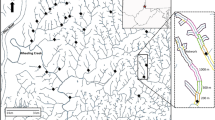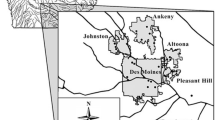Abstract
We analyzed the transverse pattern of vegetation along a reach of the Fremont River in Capitol Reef National Park, Utah, USA using models that support both delineation of wetland extent and projection of the changes in wetland area resulting from upstream hydrologic alteration. We linked stage-discharge relations developed by a hydraulic model to a flow-duration curve derived from the flow history in order to calculate the inundation duration of 361 plots (0.5 × 2 m). Logistic regression was used to relate plant species occurrence in plots to inundation duration. A weighted average of the wetland indicator values of species was used to characterize plots as Aquatic, Wetland, Transitional, or Upland. Finally, we assessed how alterations in the flow duration curve would change the relative widths of these four zones. The wetland indicator values of species and the wetland prevalence index scores of plots were strongly correlated with inundation duration. Our results support the concept that plants classified as wetland species typically occur gradient study reach of the Fremont River that satisfied the vegetation criterion for a regulatory wetland was narrow (2 m wide). Both the unvegetated Aquatic zone (7.8 m) and the Transitional zone (8 m) were substantially wider. The Transitional zone included the maxima of several species and was, therefore, not merely a combination of elements of the Wetland and Upland zones. Multiplicative increases or decreases in streamflow regime produced a wetter, or drier, bottomland vegetation, respectively. Systematic reductions in flow variability reduced the width of both the Wetland and Transitional zones and increased the width of the Upland zone. Our approach is widely applicable to inform water management decisions involving changes in flow regime.
Similar content being viewed by others
Literature Cited
Arcement, G. J. and V. Schneider. 1989. Guide for selecting Manning’s roughness coefficients for natural channels and flood plains. United States Geological Survey Water Supply Paper 2339.
Auble, G. T., J. M. Friedman, and M. L. Scott. 1994. Relating riparian vegetation to present and future streamflows. Ecological Applications 4:544–554.
Auble, G. T. and M. L. Scott. 1998. Fluvial disturbance patches and cottonwood recruitment along the upper Missouri River, MT. Wetlands 18:546–556.
Auble, G. T., M. L. Scott, J. M. Friedman, J. Back, and V. J. Lee. 1997. Constraints on establishment of plains cottonwood in an urban riparian preserve. Wetlands 17:138–148.
Bedinger, M. S. 1979. Forests and flooding with special reference to the White River and Ouachita River basins, Arkansas. United States Geological Survey, Water-Resources Investigations Open-File Report 79-68.
Bendix, J. 1994. Scale, direction, and pattern in riparian vegetationenvironment relationships. Annals of the Association of American Geographers 84:652–665.
Bendix, J. 1999. Stream power influence on southern California riparian vegetation. Journal of Vegetation Science 10:243–252.
Brinson, M. M. 1993. A hydrogeomorphic classification of wetlands. U.S. Army Corps of Engineers, Waterways Experiment Station. Bridgham and Richardson, Vicksburg, MS, USA. Wetlands Research Program Technical Report WRP-DE-4.
Brinson, M. M., B. L. Swift, R. C. Plantico, and J. S. Barclay. 1981. Riparian ecosystems: their ecology and status. U. S. Fish and Wildlife Service, Kearneysville, WV, USA. FWS/OBS-81/17.
Castelli, R. M., J. C. Chambers, and R. J. Tausch. 2000. Soil-plant relations along a soil-water gradient in great basin riparian meadows. Wetlands 20:251–266.
Chapin, D. M., R. L. Beschta, and H. W. Shen. 2002. Relationships between flood frequencies and riparian plant communities in the Upper Klamath Basin, Oregon. Journal of the American Waters Resources Association 38:603–617.
Everitt, B. L. 1995. Hydrologic factors in regeneration of Fremont cottonwood along the Fremont River, Utah. p. 208–219. In Costa, J. E., A. J. Miller, K. W. Potter, and P. R. Wilcock (eds.) Natural and Anthropogenic Influences in Fluvial Geomorphology. American Geophysical Union, Washington DC, USA. Geophysical Monograph 89.
Franz, E. H. and F. A. Bazzaz. 1977. Simulation of vegetation response to modified hydrologic regimes: a probabilistic model based on niche differentiation in a floodplain forest. Ecology 58: 176–183.
Friedman, J. M. and G. T. Auble. 1999. Mortality of riparian box elder from sediment mobilization and extended inundation. Regulated Rivers: Research and Management 15:463–476.
Friedman, J. M. and G. T. Auble. 2000. Floods, flood control, and bottomland vegetation. p. 219–237. In E. E. Wohl (ed.) Inland Flood Hazards. Cambridge University Press, Cambridge, UK.
HEC (Hydrologic Engineering Center). 1998. HEC-RAS river analysis system, Version 2.2. U.S. Army Corps of Engineers, Davis, CA, USA.
Hosmer, D. W. Jr. and S. Lemeshow. 1989. Applied Logistic Regression. John Wiley & Sons. New York, NY, USA.
Hughes, F. M. R. 1994. Environmental change, disturbance and regeneration in semi-arid floodplain forests. p. 321–345. In A. C. Millington and K. Pye (eds.) Environmental Change in Drylands: Biogeographical and Geomorphological Perspectives. John Wiley & Sons, Ltd. New York, NY, USA.
Hupp, C. R. and W. R. Osterkamp. 1985. Bottomland vegetation distribution along Passage Creek, Virginia, in relation to fluvial landforms. Ecology 66:670–681.
Johnson, R. R. and C. H. Lowe. 1985. On the development of riparian ecology. P. 112–116. In Johnson, R. R., C. D. Ziebell, D. R. Patton, P. F. Ffolliott, and R. H. Hamre (technical coordinators) U.S. Department of Agriculture Forest Service General Technical Report RM-120.
Johnson, G. D., M. D. Strickland, J. P. Buyok, C. E. Derby, and D. P. Yong. 1999. Quantifying impacts to riparian wetlands associated with reduced flows along the Greybull River, Wyoming. Wetlands 19:71–77.
Leitman, H. M., J. E. Sohm, and M. A. Franklin. 1983. Wetland hydrology and tree distribution of the Apalachicola River flood plain, Florida. U.S. Geological Survey Water-Supply Paper 2196.
Lowe, C. H. 1964. Arizona landscapes and habitats. p. 1–132. In C. H. Lowe (ed.) The Vertebrates of Arizona. University of Arizona Press, Tucson, AZ, USA.
Malanson, G. P. 1993. Riparian Landscapes. Cambridge University Press, Cambridge, UK.
Merritt, D. M. and D. J. Cooper. 2000. Riparian vegetation and channel change in response to river regulation: a comparative study of regulated and unregulated streams in the Green River Basin, USA. Regulated Rivers: Research and Management 16: 543–564.
Michener, M. C. 1983. Wetland site index for summarizing botanical studies. Wetlands 3:180–191.
Nagelkerke, N. J. D. 1991. A note on a general definition of the coefficient of determination. Biometrika 78:691–692.
NRC (National Research Council). 1995. Wetlands: Characteristics and Boundaries. National Academy Press, Washington, DC, USA.
NRC (National Research Council). 2002. Riparian Areas: Functions and Strategies for Management. National Academy Press. Washington, DC, USA.
Ohmart, R. D., B. W. Anderson, and W. C. Hunter. 1988. The ecology of the lower Colorado River from Davis Dam to the Mexico-United States International Boundary: a community profile. U.S. Fish and Wildlife Service, Washington, DC, USA. Biological Report 85(7.19).
Patten, D. T. 1998. Riparian ecosystems of semi-arid North America: diversity and human impacts. Wetlands 18:498–512.
Prentice, I. C. and A. M. Solomon. 1991. Vegetation models and global change. p. 365–383. In R. S. Bradley (ed.) Global Changes of the Past. UCAR/Office of Interdisciplinary Earth Sciences, Boulder, CO, USA.
Primack, A. G. B. 2000. Simulation of climate-change effects on riparian vegetation in the Pere Marquette River, Michigan. Wetlands 20:538–547.
Reed, P. B. 1988. National list of plant species that occur in wetlands: National summary. United States Fish and Wildlife Service, Washington, DC, USA. Biological Report 88(24).
Romme, W. H., K. D. Heil, J. M. Porter, and R. Fleming. 1993. Plant communities of Capitol Reef National Park, Utah. National Park Service, Technical Information Center, Denver, CO, USA. NPS D-56.
SAS. 1999. SAS/STAT User’s Guide, Version 8. SAS Institute Inc., Cary, NC, USA.
Scott, M. L., J. M. Friedman, and G. T. Auble. 1996. Fluvial process and the establishment of bottomland trees. Geomorphology 14: 327–339.
Shafroth, P. B., J. C. Stromberg, and D. T. Patten. 2002. Riparian vegetation response to altered disturbance and stress regimes. Ecological Applications 12:107–123.
Smith, R. D. 1996. Composition, structure, and distribution of woody vegetation on the Cache River floodplain, Arkansas. Wetlands 16:264–278.
Stromberg, J. C., J. Fry, and D. T. Patten. 1997. Marsh development after large floods in an alluvial arid-land river. Wetlands 17:292–300.
ter Braak, C. J. F. and C. W. N. Looman. 1995. Regression. p. 29–76. In R. H. G. Jongman, C. J. F. ter Braak, and, O. F. R. van Tongren (eds.) Data Analysis in Community and Landscape Ecology. Cambridge University Press, Cambridge, UK.
Tiner, R. W. 1999. Wetland Indicators: a Guide to Wetland identification, Delineation, and Mapping. Lewis Publishers, New York, NY, USA.
USDA-NRCS. 2003. The PLANTS Database, Version 3.5 (http://plants.usda.gov). National Plant Data Center, Baton Rouge, LA, USA.
USDA-SCS. 1994. National Food Security Act Manual. U.S. Department of Agriculture, Soil Conservation Service, Washington, DC, USA. 180-V-NFSAM, third edition.
Wakeley, J. S. 2002. Developing a “regionalized” version of the Corps of Engineers wetlands delineation manual: issues and recommendations. U.S. Army Engineer Research and Development Center, Vicksburg, MS, USA, ERDC/EL TR-02-20.
Wells, B. W. 1928. Plant communities of the coastal plain of North Carolina and their successional relations. Ecology 9:230–242.
Wentworth, T. R., G. P. Johnson, and R. L. Kologiski. 1988. Designation of wetlands by weighted averages of vegetation data: a preliminary evaluation. Water Resources Bulletin 24:389–396.
Wharton, C. H., W. M. Kitchens, E. C. Pendleton, and T. W. Swipe. 1982. The ecology of bottomland hardwood swamps of the Southeast: a community profile. U.S. Fish and Wildlife Service, Washington, DC, USA FWS/OBS/81-37.
Williams, G. P. and M. G. Wolman. 1984. Downstream effects of dams on alluvial rivers. U.S. Geological Survey Professional Paper 1286.
Author information
Authors and Affiliations
Rights and permissions
About this article
Cite this article
Auble, G.T., Scott, M.L. & Friedman, J.M. Use of individualistic streamflow-vegetation relations along the Fremont River, Utah, USA to assess impacts of flow alteration on wetland and riparian areas. Wetlands 25, 143–154 (2005). https://doi.org/10.1672/0277-5212(2005)025[0143:UOISRA]2.0.CO;2
Received:
Revised:
Accepted:
Issue Date:
DOI: https://doi.org/10.1672/0277-5212(2005)025[0143:UOISRA]2.0.CO;2




